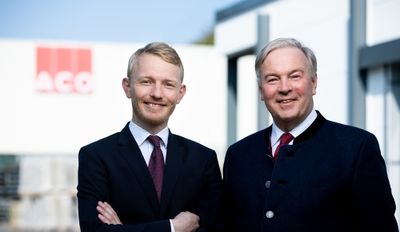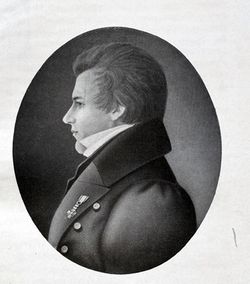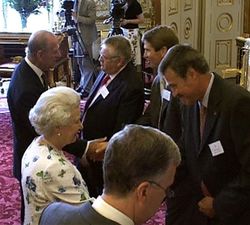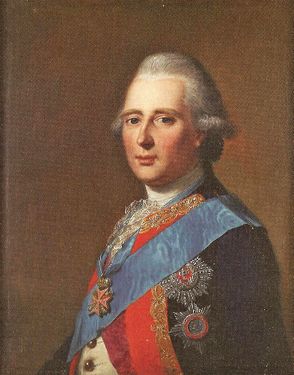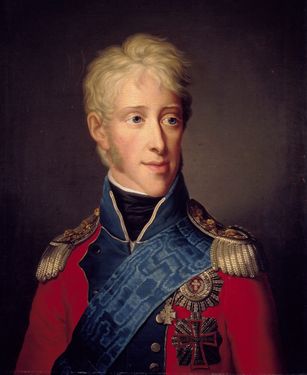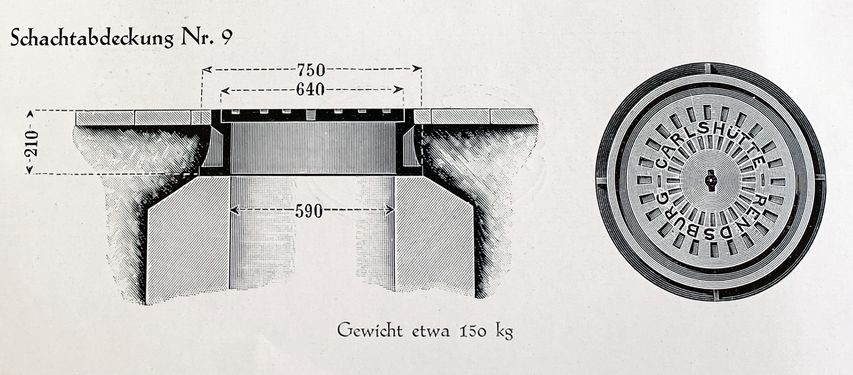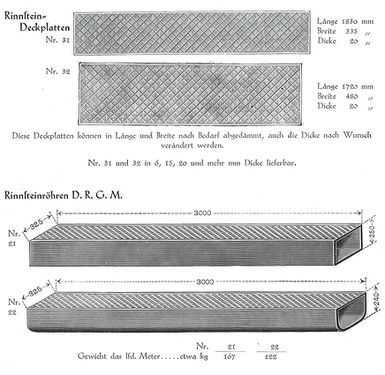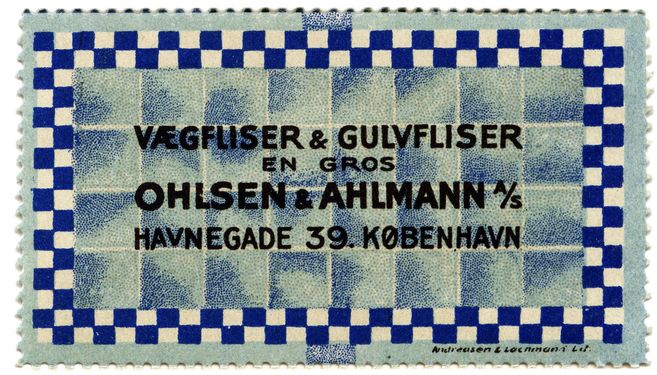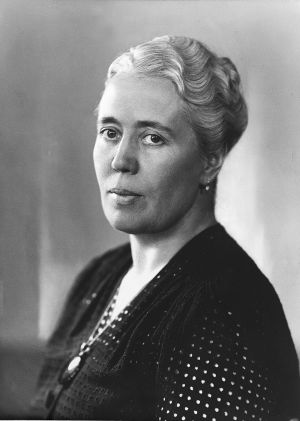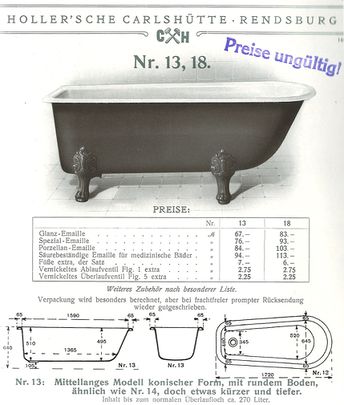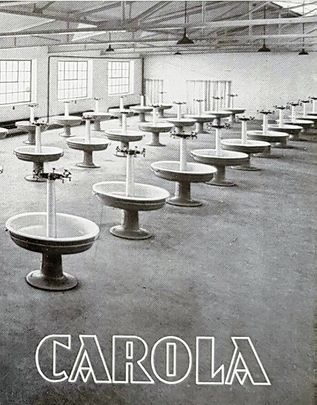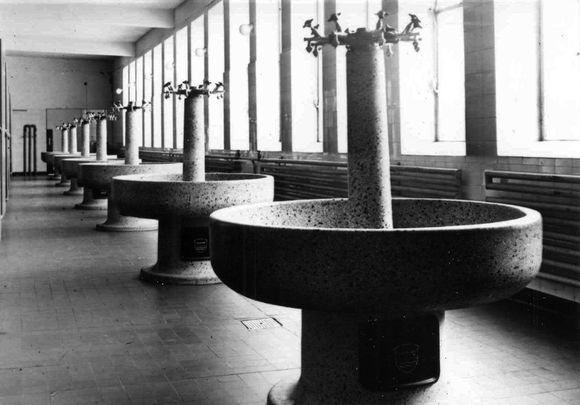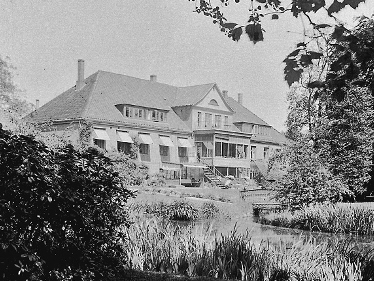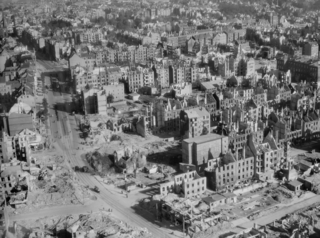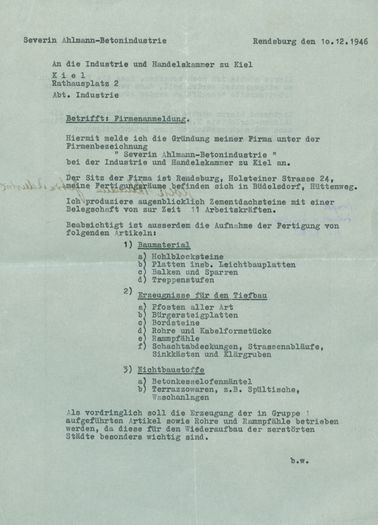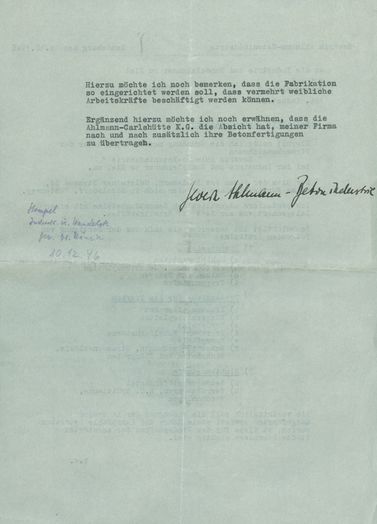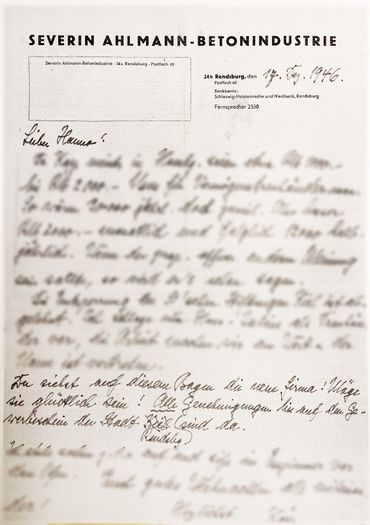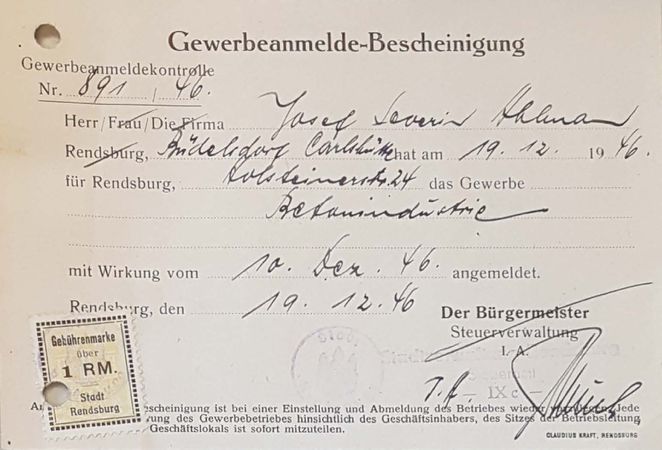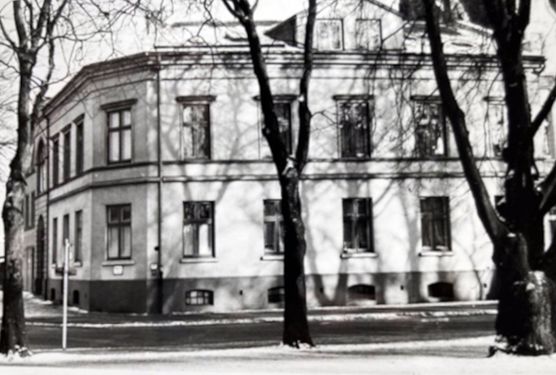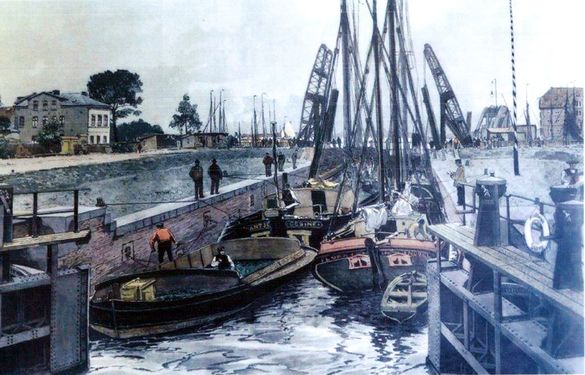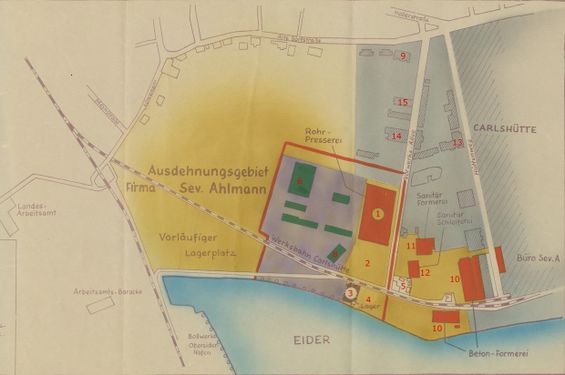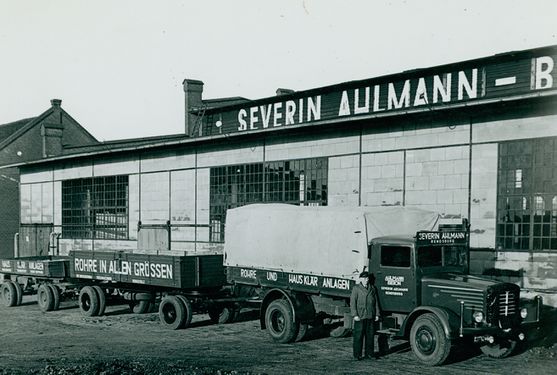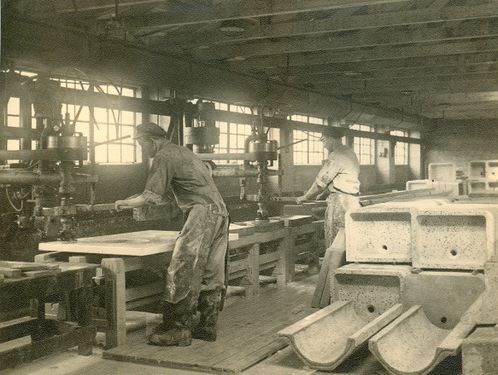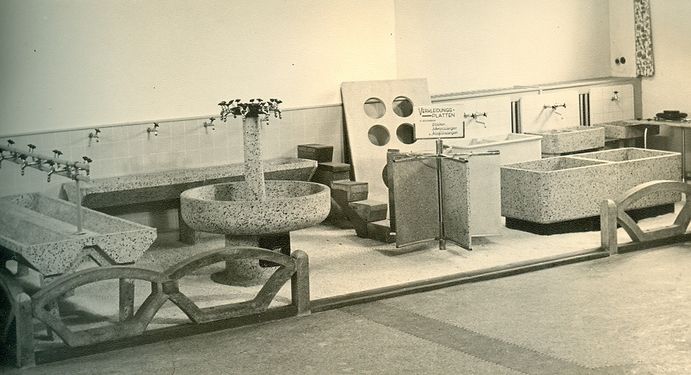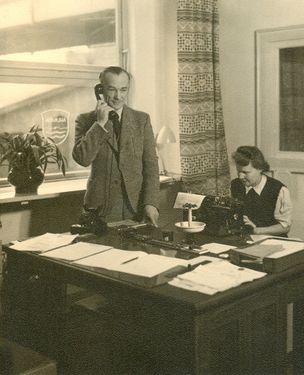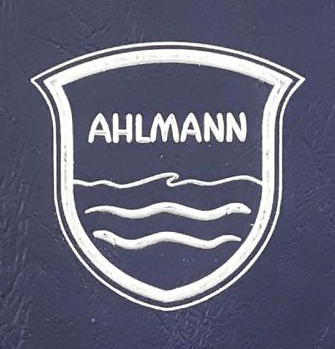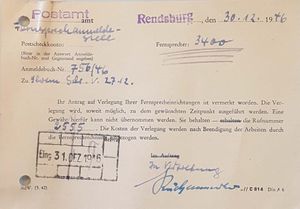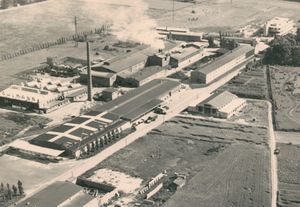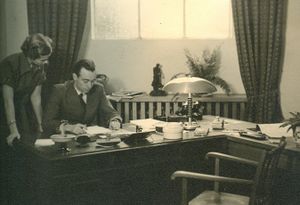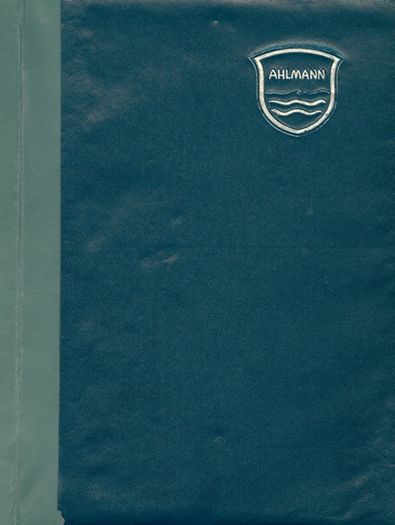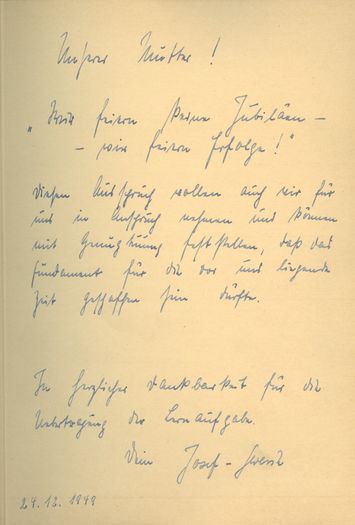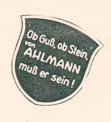Main Page
The ACO 75th Anniversary History Wiki
Welcome to the ACO History Wiki, which is launched in ACO's anniversary year.
The Wiki contains exciting stories about ACO. The history of the company's founding and its early years, locations and subsidiaries, products and services, employees, customers and suppliers, working life and the Ahlmann family of entrepreneurs – these are all topics that are presented in pictures covering the many years of the company’s history. Interesting correlations become clear, insights possible, and also amusing facts come to light. Here you can find out everything about how the globally-active world-market leader in drainage technology, gradually developed from small regional beginnings in Büdelsdorf in Schleswig-Holstein.
The Wiki is an ongoing project that is constantly being expanded. By the 75th anniversary of the company's founding in December 2021, much of the company's history should have been researched and documented.
You are welcome to contribute to this project. Do you have pictures or documents on any aspect of ACO’s history? Can you think of any stories that are "typically ACO"? We look forward to your contributions. Contact us at: info@history.aco ! (as of June 2021)
The history of ACO
ACO - Foundation and first years 1946 to 1949
ACO's origin: the Carlshütte
ACO is a spin-off from the venerable Carlshütte foundry, which is steeped in tradition, and was established in 1827 – almost 200 years ago – in Büdelsdorf near Rendsburg in Schleswig-Holstein. The Carlshütte was the very first industrial enterprise on the Jutland peninsula and, above all, the first ironworks in the whole of Denmark. The founder was the merchant Markus Hartwig Holler. He ran a flourishing timber business in Rendsburg, but wanted to build an iron foundry in Büdelsdorf.
Holler was completely in tune with the times. He recognized the importance of iron as a material for the new industrial era. In a petition to the Danish King Frederick VI, he meaningfully states:
"It is the word “iron” that explains everything".
He goes on to write that iron is "equally useful, indeed indispensable, for the state and national defence, as it is for households, farmers, trades, buildings and factories. After a visit by the Danish King Frederick VI in June 1829, the King was so impressed by Holler's work, that on his return trip he issued instructions to make Holler a Knight of the Order of Dannebrog. In the picture on the right, Holler's chest shows the medal of the Order of Dannebrog, which is still awarded today as an order of merit for civil and military service to loyal servants of the Danish state, and for special merits in the arts, sciences or economic life.
The Danish king's governor of the duchies of Schleswig and Holstein, Carl von Hessen, supported the venture from the beginning. In gratitude, Holler named the ironworks "Carlshütte" after him. The Landgrave, who was already over 80 years old at the time of the company's foundation, was descended on his mother's side from the English royal house of Hannover, and was the father-in-law of the Danish King Frederick VI. Carl von Hessen was the great-great-great-grandfather of the recently deceased Prince Philip, Duke of Edinburgh, Prince Consort of the British Queen Elizabeth II, who in 2006 presented ACO with "The Queen's Award for Enterprise".
Thus, the circle closes.
Carl was influenced by the ideas of the Enlightenment. He was interested in culture and science. He studied metallurgy and metal casting. He had a particular soft spot for alchemy. Thus, until the end of his life, he endeavoured to extract gold from an alloy of base metals. This passion could also have been a motive for his support of the Carlshütte. Irrespective of this, however, Carl von Hessen was regarded as an avid promoter of business and new industrial ventures.
The second patron and protector of the Carlshütte was the Danish King, Frederick VI. Like his governor, Carl von Hessen, he was fond of science and business. He was quickly convinced by Markus Hartwig Holler's ideas. At an audience in Rendsburg, Holler was able to present the plans for establishing the foundry in person. The king even visited the foundry construction site.
Over the next ten years, Frederick VI visited the Carlshütte again and again. As in 1829 for example, when Holler was able to report on the first tapping of the smelting furnace. In 1831, Frederick VI visited the blast furnace construction site, and he was back in Rendsburg again in 1835. The king's fifth and last visit took place in 1839: the Carlshütte was in full swing, and Holler was able to present the king with a steam engine that was built there. The founder did not forget that the economic upswing was due in no small part to a number of privileges granted by the monarch. These included the duty-free import of raw materials, the duty-free export of iron goods, and protective tariffs against foreign products.
However, the blast furnace only worked for a few years. The production of iron from bog iron ore, which occurs in Schleswig-Holstein in readily usable quantities, proved unprofitable, so smelting was abandoned, and the company switched exclusively to foundry operations.
The Carlshütte produced cast-iron utensils and objects for the household, road construction, agriculture and shipbuilding. Fascinatingly, the Carlshütte had products in its range that ACO also manufactures today, albeit with different materials. These are window frames, cribs and troughs, and animal pens, also sewer and manhole covers, light oil separators, gutters with cover grates, and finally, sanitary items such as bathtubs and cast-iron water closets.
Read more:
- The history of Carlshütte until 1946.
The Ahlmann family at the Carlshütte
The Ahlmann family was to play a key role in the development of the Carlshütte, and in the founding of ACO. The German-Danish merchant and entrepreneurial family Ahlmann has been resident in Denmark and in the duchies of Schleswig and Holstein since the 16th century. Thomas Jörgen Ahlmann, the great-great-grandfather of Hans-Julius Ahlmann, established the first connection with the Carlshütte in 1840. He went into business with Holler, and set up a commission warehouse for the Carlshütte's goods in Fredericia, Denmark. From here, Carlshütte products were distributed to the Scandinavian countries. At the time, there were no agents, but instead, wholesalers who were trusted partners. Thomas Jörgen Ahlmann also founded the distillery & brewery "Ahlmann & Co" in 1842. This company name, especially the abbreviation "ACO" derived from it, was to gain special importance more than a hundred years later.
Thomas' second eldest son, Johannes Ahlmann took over his father's business together with his brother-in-law Dethlef Ohlsen, which then traded as "Ohlsen & Ahlmann" from 1878. In the following year, the two merchants moved the Carlshütte commission warehouse to Copenhagen. Hartwig Peter Holler – the son of the founder of the Carlshütte – was so convinced of Johannes Ahlmann's abilities that he offered him the post of commercial director at the Carlshütte, which he accepted in 1883. At this time, the Carlshütte was a public limited company. Over the next few decades, Johannes Ahlmann modernised the company, expanded it, and introduced new products, especially enamelled bathtubs, which made the Carlshütte world-famous. In 1900, more than 1,000 workers were employed in the company. The Copenhagen enterprise was later sold to the large Danish trading company Brødrene Dahl.
In 1907, Johannes Ahlmann's son Julius joined the Carlshütte. Julius succeeded his father as commercial director in 1919, and continued the successful modernisation course. However, he died of a serious illness in 1931. His widow Käte Ahlmann was determined to preserve the company's heritage for the next generation. In 1937, she succeeded in acquiring all the shares for the family, and transformed the public limited company into a KG. Käte Ahlmann took over the management of the Carlshütte, which from then on was a family business. In the same year, parts made of asbestos cement were produced for the first time. This gave rise to a concrete division.
Read more:
- The biography of Käte Ahlmann until 1946
- History of the Ahlmann family
The beginnings of the concrete division – use of substitutes for iron
Substitute for cast iron feet for bathtubs at the Carlshütte
The forced conversion of the German economy to war production from the mid-1930s onwards gave rise to manufacturing restrictions in the steel and iron industry: metals were to be saved in the civilian sector so that they could be used for armaments. Central to this was the 1936 Four-Year Plan, with which the economic and military war capability of the German Reich was to be achieved within four years. Within the framework of the Four-Year Plan, the bathtub industry undertook to produce models with a minimum of iron components. From April 1937, the factories were ordered to no longer use cast iron feet for built-in bathtubs. The Carlshütte found a replacement in just a few months: bathtub feet and pedestals were initially made of stoneware, and later in the year they were also made of concrete.
Further savings of iron
On 15 August 1937, the iron and steel supervisory authority ordered a production restriction of 30 percent compared to the production from 1 July 1935 to 30 June 1936 in the entire sanitary and sewer castings sector. This dramatically affected the Carlshütte. Initially, it was possible to fall back on stocks. Thus, from August to December 1937, the Carlshütte recorded only a 17.5 percent decline in sales of foundry products. Asbestos cement panels were used as a substitute for cast-iron underlays for continuous firing furnaces, and these were then also used for the back walls and floors of coal and gas cookers. Iron savings of 20 kg per cooker were achieved with the asbestos cement panels. The Carlshütte annual report of 1937 described the consequences of the manufacturing restrictions and bans: "The sales policy during 1937 was therefore essentially determined by the question of raw material procurement and the use or creation of adequate substitutes."
Cast terrazzo for the wash fountains, fireclay and ceramics for stoves
In 1938, Carlshütte pushed ahead with the use of substitute raw materials. Terrazzo – a mixture of colour-selected aggregates, water, lime and cement – was used as cast terrazzo for the Carlshütte washing fountains, which were previously made of cast iron. For the ovens, fireclay walls were installed in place of the cast-iron walls to save iron. Further savings were achieved by using ceramic ash boxes. New to the Carlshütte range were concrete boiler stoves, which were delivered from March 1938. With the compulsory use of the new materials, which were not characteristic of an iron foundry, a concrete division was set up at the Carlshütte, from which the Severin Ahlmann-Betonindustrie (SAB), later ACO Severin Ahlmann, was established.
Josef-Severin Ahlmann – responsible for the concrete division at the Carlshütte.
The Second World War broke out in 1939. Käte Ahlmann's sons Hans-Julius and Josef-Severin were called up for military service. The factory survived the war largely unscathed. In May 1945, Käte Ahlmann's second-born son Josef-Severin returned from the war. Schleswig-Holstein, including Büdelsdorf, was part of the British occupation zone.
The Carlshütte family business was subject to production restrictions imposed by the military government. However, it was allowed to produce concrete parts for civilian purposes. These were "simple building slabs", agricultural troughs and cement roof tiles.
Josef-Severin immediately took over management tasks in the company on behalf of his mother. He took care of the concrete production at the Carlshütte. At the age of 22, he became department head of the Carlshütte concrete division.
Severin's brother Hans-Julius also returned from captivity at the beginning of 1946. He had already had power of attorney for several years, and was designated by his mother as her successor in the management of the Carlshütte.
Read more:
- Special:MyLanguage/The end of the Second World War in Schleswig-Holstein
- Special:MyLanguage/The biography of Josef-Severin Ahlmann until 1946
- Special:MyLanguage/The biography of Hans-Julius Ahlmann senior
Establishment of Severin Ahlmann-Betonindustrie (SAB), later ACO
In the course of 1946, Käte Ahlmann, and Hans-Julius and Severin Ahlmann, decide to spin off the concrete division from the Carlshütte as an independent company. The background to this was fear that the Carlshütte would be dismantled by the Allies. On 1 October 1946, the British military government informed the Carlshütte management that the plant was earmarked for dismantling as part of the reparation demands.
The specific reason for the timing of the company establishment before the end of the year was the result of the local elections in Schleswig-Holstein on 13 October 1946, in which the SPD won 41.1 percent of the vote. It was assumed that the Social Democrats would also gain a majority in the state elections scheduled for the following year. The worry was that they would implement expropriation plans. The Social Democrats and the trade unions propagated the expropriation of key industries or companies that were involved in the armaments industry during the Second World War, including the Carlshütte. Käte Ahlmann wrote in a letter on 13 December: "We thought this measure (meaning the company registration) was still the right thing to do in the old year, since one never knows what new prohibitions will come at the end of this year."
In order to secure at least one segment of the business for the family, Josef-Severin Ahlmann registered the company "Severin Ahlmann-Betonindustrie" with the Kiel Chamber of Industry and Commerce on 10 December 1946. SAB, as the company name was abbreviated, later became ACO.
Read more:
- Denazification in the British Zone
- The British dismantling policy in the post-war years
The product range of Severin Ahlmann-Betonindustrie (SAB, later ACO)
It was clear from the company registration letter that the production of new articles was to be started step by step. Three product groups were mentioned: Firstly, building materials for house construction: such as hollow blocks, slabs and lightweight panels, beams and rafters, as well as stair treads. Furthermore, products for civil engineering were also to be manufactured. These included posts, pavement slabs, kerbstones, pipes and cable fittings, driven piles, as well as manhole covers, street drains, cesspits and septic tanks. Finally, it was planned to also produce "non-building materials", meaning products for interior finishing, such as concrete boiler stove jackets and, in particular, terrazzo goods, such as sinks and washbasins.
The articles of the first and second product group were the main priority, explained Severin Ahlmann, because they were "particularly important for the reconstruction of the destroyed cities". In Kiel, for example, 35 percent of all buildings were destroyed, 40 percent were damaged. In the future expansion of labour, more women were to be employed. Production was to be set up accordingly.
The letter concludes with a reference to good order prospects because the Carlshütte intended to successively transfer the entire concrete production to the new Severin Ahlmann-Betonindustrie.
The company registration at the Kiel Chamber of Industry and Commerce was processed quickly. The trade registration certificate with the number 891/46 for the trade "concrete industry" – the birth certificate of ACO, so to speak – was issued on 19 December 1946. The retroactive effect to the 10th of the month was noted.
Read more:
- More original documents and letters on the founding of SAB.
Company headquarters in Rendsburg - production facilities in Büdelsdorf
The company's first registered office was not in Büdelsdorf, but Rendsburg. The address was Holsteiner Straße 24, where the Carlshütte kindergarten was also located. Severin Ahlmann later liked to say:"ACO was founded in a kindergarten on an Eider lock." The address – some distance from the Carlshütte – underlines the character of an independent establishment. It was a strategic decision vis-à-vis the authorities.
The production facilities, however, were located on Hüttenweg in Büdelsdorf on the Carlshütte site. Käte Ahlmann leased the site and buildings to SAB.
The first company headquarters at Holsteiner Straße 24 in Rendsburg. Gesa Meyer, the daughter of the first managing director Paul Meyer, was one of the kindergarten children at the time and recalls: "Our father's office was on the ground floor, to the left of the main entrance, and just behind it was Josef-Severin Ahlmann's office, with a wonderful soft, dove-blue carpet."
Plan clearly showing - in yellow - the expansion of the young company SAB. Outlined in red is the square that was the subject of the deal with the timber merchant Timm and the town. Yellow is the Severin Ahlmann company, and purple is the company H.F. Timm. The buildings in detail: 1) Pipe pressing plant, 2) Severin Ahlmann storage yard, 3) Severin Ahlmann storage yard, 4) Severin Ahlmann storage yard, 5) Carlshütte residential building, today Vorwerk office, 6) Thormann Hall (built in 1890), 7) Severin Ahlmann office in the Carlshütte, 8) Horse stables (built in its first form around 1784), 9) Director's house, 10) Concrete moulding shop, 11) Sanitary moulding shop, 12) Sanitary polishing shop, 13) Haus & Garden Ahlmann, 14) Coach house (built in 1913), 15) Alte Meierei.
Workforce and products
Carlshütte and SAB were closely connected. Friedrich Sensen, Käte Ahlmann's deputy at the Carlshütte, recommended his brother-in-law Paul Meyer as an authorised signatory and de facto managing director of SAB. Meyer had a decisive influence on the company in the early years at Severin Ahlmann's side. He was instrumental in SAB's success.
At the time of the company's registration, SAB had only eleven employees. Soon the number of employees rose to 100. From the beginning, Severin Ahlmann employed refugees and displaced persons from the former German eastern territories, and the Soviet occupation zone. They became a success factor for the young company.
The warehouse (factory building IV) at SAB. Concrete roof tiles can be seen on the right. For the British Rhine-Army and other British services, Carlshütte produced 42,000 stoves in 1945/46, 40,000 Canada stoves, 40,000 cookers, 100 large cookers, 3,500 bath tubs, 10,000 radiators, 5,000 washing kettles and also 50,000 aluminium roof tiles. Concrete was also used for roof tiles. This production was done on a large scale by SAB. Concrete roof tiles are an important product for SAB. Gerd Ostryga, who started at the Carlshütte on 17 November 1946, and shortly afterwards moved to the new Severin Ahlmann-Betonindustrie (SAB, later ACO), recounts in his memoirs that one of his first tasks was to form concrete roof tiles.
Read more:
- Special:MyLanguage/SAB employees recollect the early years
The first logo of SAB (later ACO)
The first logo of the newly founded Severin Ahlmann-Betonindustrie consisted of a coat of arms with stylised Ahlmann lettering. The coat of arms originally came from Bankhaus Ahlmann in Kiel, and was used by Severin Ahlmann to highlight the long family tradition. The logo was later used as a model for the logos of other Ahlmann companies.
Work under difficult conditions
The production permit for SAB did not arrive until March 1947. Until then, the permit issued to the Carlshütte was valid.
Production was by no means easy in the post-war period. There were shortages everywhere. This applied to food and everyday items, as well as to raw materials and energy. Parts of the infrastructure were still not repaired. Almost all resources were regulated by the authorities.
At the end of March 1947, the city of Rendsburg allocated SAB a certain amount of electricity: 15,000 kWh per month.
In mid-May 1947, the Rendsburg post office informed Severin Ahlmann that his application for "Permission for unrestricted voice telephony within the British zone" was granted. He had to wait a long time for this: the application had been submitted six months earlier. Severin Ahlmann was able to keep an existing telephone number - 2555. In addition, he was given the opportunity to register for call prioritisation by dialling a specific code number.
The foundation of Ahlmann & Co. in Andernach
On 1 November 1948, Ahlmann & Co. was founded in Andernach, Rhineland-Palatinate. The aim of establishing this company – similar to the establishment of Severin Ahlmann-Betonindustrie two years earlier – was to secure the family and its entrepreneurial activities in view of the uncertain political and economic future. Andernach was located in the French occupation zone. It was hoped that dismantling and expropriation plans would be pursued less intensely here, or not at all. Moreover, Käte Ahlmann, who comes from the Rhineland, had close ties to the region.
Another reason for the Ahlmann family to hedge their bets was the beginning of the "Cold War". The blockade of Berlin by the Soviet Union fuelled the fear of escalation. Andernach, which was further away from the East Zone border, and lay mainly on the other side of the Rhine, appeared to be a "safe fallback location" in case the Red Army advanced to the Rhine.
Purely economic motives also played a role. An iron foundry and an enamelling plant were to be built in Andernach. The product range corresponded to that of the Carlshütte: cast iron tubs, washers and other sanitary castings. The new plant was an extension of the Carlshütte, which was to supply the French and American zones with these products.
The project was approved at the beginning of February. At the end of May 1949, construction work began and progressed rapidly. In the following years, there was an exchange of personnel between Severin Ahlmann-Betonindustrie (SAB) and the newly founded company in the Rhineland. This was accompanied by a fruitful transfer of know-how.
Another important aspect: Ahlmann & Co. later provided the abbreviation for the group's current name: ACO. Josef-Severin Ahlmann later recalled that the business liked to refer to Thomas Jörgen Ahlmann's company Ahlmann & Co. established in Fredericia in 1842.
Read more:
- - On the establishment of Ahlmann & Co. in Andernach
SAB in 1949
Käte Ahlmann was exonerated in the denazification proceedings, the accounts were unblocked, the Carlshütte was not dismantled.
However, a reincorporation of concrete production into the Carlshütte was not an issue. SAB remained an independent company, had made a name for itself, and was growing. In 1949, the turnover was DM 665,000, more than four times the turnover two years earlier. The number of customers doubled in the same period. In 1949 there were 550.
Severin Ahlmann had married in the meantime. His wife Maria Luise, née Guthe, worked in the company. A photo album made by Severin Ahlmann in 1949 gives an insight into the early days of the company.
Special:MyLanguage/You can browse through the entire photo album here.
Severin's dedication to his mother Käte Ahlmann. He wrote: "To our mother! 'We don't celebrate anniversaries - we celebrate successes!' We also want to claim this saying for ourselves, and can state with satisfaction that the foundations for the future have been laid. With heartfelt gratitude for entrusting us with this ongoing task. Your Josef-Severin. 24.12.1949"
ACO from 1950 – the next steps in the ACO Wiki
Dear Readers,
The ACO story does not end in 1949, of course: it remains exciting right up to the present day. In the coming months, the ACO history wiki will be expanded step by step to include more history and stories from and about ACO.
Enjoy reading, browsing and discovering!
Your ACO Wiki Team
